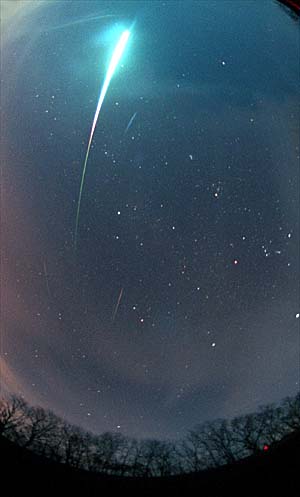
|
Credit & Copyright: V. Winter & J. Dudley,
ICSTARS Astronomy
Explanation:
The
1998 Leonid Meteor Shower featured many bright events.
Extremely bright meteors, known as bolides or
fireballs,
can briefly glow brighter than the
full moon.
Pictured
above is a
Leonid bolide
caught during a five-minute, wide-angle exposure.
The bolide was so bright it lit up the surrounding area,
making otherwise dark trees visible. Also visible are at
least three other meteors, numerous bright stars, and the
constellation Orion. This meteor shower is called the
Leonids
because most of the meteors move out from the constellation Leo. At this location near the Powell Observatory in Kansas,
over 200 meteors per hour were reported.
|
January February March April May June July August September October November December |
| |||||||||||||||||||||||||||||||||||||||||||||||||||||||
NASA Web Site Statements, Warnings, and Disclaimers
NASA Official: Jay Norris. Specific rights apply.
A service of: LHEA at NASA / GSFC
& Michigan Tech. U.
Based on Astronomy Picture
Of the Day
Publications with keywords: Leonids - meteor
Publications with words: Leonids - meteor
See also:
- APOD: 2025 August 25 Á The Meteor and the Star Cluster
- APOD: 2025 August 6 Á Meteor before Galaxy
- APOD: 2024 November 27 Á The Meteor and the Comet
- Meteor over the Bay of Naples
- Fireball over Iceland
- APOD: 2023 August 23 Á The Meteor and the Galaxy
- APOD: 2023 July 16 Á Meteor and Milky Way over the Alps
